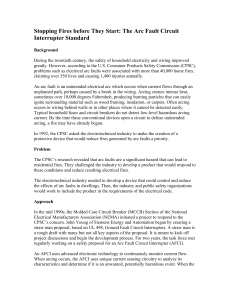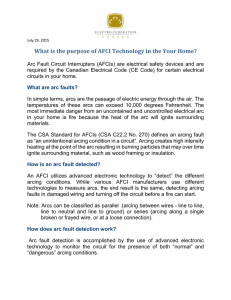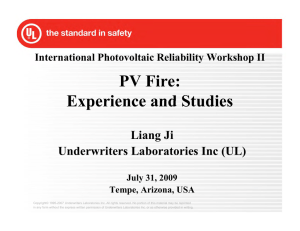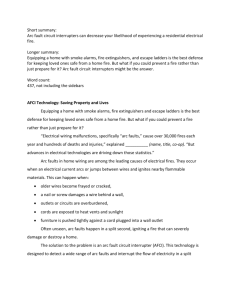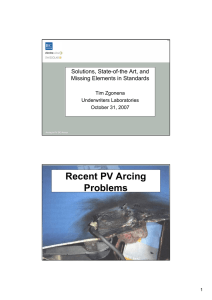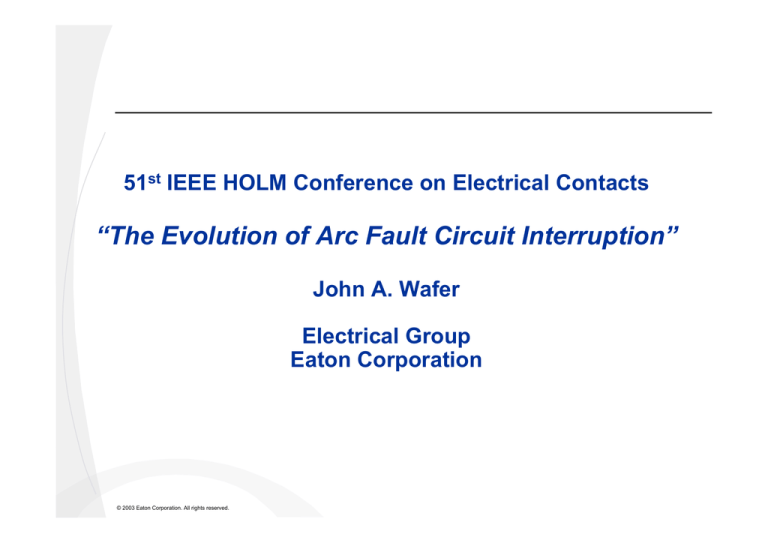
51st IEEE HOLM Conference on Electrical Contacts
“The Evolution of Arc Fault Circuit Interruption”
John A. Wafer
Electrical Group
Eaton Corporation
© 2003 Eaton Corporation. All rights reserved.
Residential Electrical Fires
Each year in the United
States, approximately
70,000 residential fires,
attributed to electrical
initiation, cause more
than 500 deaths and $1B
in property damage .
Ref: AFCI Inquiry and Report CPSC and NASFM August 1, 2002
2
Traditional Circuit Protection
Traditionally, circuit
breakers and fuses have
provided overcurrent and
short circuit protection in
electrical distribution
applications. When
electrically initiated fires
were investigated it was
found that, in some cases,
the circuit breaker had not
tripped.
3
Conditions that can lead to arcing faults
4
A Problem Identified
The need for enhanced protection was recognized in the
late 1980’s. The Consumer Product Safety Commission
(CPSC), Underwriters Laboratories (UL), the Electronic
Industry Association (EIA), several major industrial
electrical manufacturers, and some forensic fire
investigators became advocates for enhanced safety.
Research and development was done to understand the
phenomena involved and find practical solutions.
5
The cause discovered
It was found that if an electrical cord was damaged,
intermittent and sputtering arcing current could be
initiated, which would not cause an RMS sensing device
to open the circuit. The RMS values of these fault
currents could be much lower than the trip threshold
that these devices were designed to respond to.
Essentially the actual arcing times are too short to
release the tripping mechanism.
This arcing could continue until a fire was initiated if
suitable combustible materials are in the vicinity.
6
The solution proposed
The first AFCIs could recognize the unique signatures of arcing
faults and initiate a trip condition to isolate and de-energize the
arcing fault. These AFCI circuit breakers were first introduced in
1999 as described in the IAEI article “Arc-Fault Circuit Interrupters”
by Dr. C. Kimblin, Dr. Joe Engel and Bob Clarey (July 2000).
7
Additional Concerns
Other conditions that can lead to fire hazards
will be further discussed such as arcs-toground, various wire failure modes, earth
leakage conditions and high resistance
contact faults such as glowing contacts.
Low current series arcs due to a break in a
conductor will also be discussed.
8
The Results
z
z
z
Approximately 15 million AFCIs have been
installed in the field.
Their performance has been excellent.
The National Association of State Fire
Marshals (NASFM) has been most supportive
in encouraging adoption of this technology.
9
History
z
z
The electrical arc has been studied over the
years - since the invention of electrical power.
It is most interesting to read the work of the
scientists who were pioneers in this area:
Faraday, Westinghouse, Edison, Tesla, etc.
Many safety innovations have been developed
over time: the fuse, the circuit breaker,
personnel ground fault protection, earth
leakage protection, zone selective interlocking,
current limiting, etc.
10
History
z
Arcing phenomena and safety have been areas
of continuous investigation and improvement
over the full range of voltage applications.
11
Physics of Arcing Faults
z
z
The high temperature ionized plasma that forms the arc
(>5000º C) can, under certain conditions, if not detected
and isolated, initiate fire.
The arc sustainability depends on many factors:
Voltage, Gap, Available Fault Current, Load, Adjacent
Materials (such as insulation and materials that can be
carbonized), Materials that can liberate combustible
gases when heated, Local Cooling and Deionization,
Thermionic Emission Materials, Surges, etc. There are
many variables.
Reference: Dr. Clive Kimblin - NEC Digest (June 2005)
“Arc- Fault Circuit Interrupters”
12
“Safe” Arcing
In our homes, there are many different kinds of loads with
various associated current waveforms. Many devices can
be on the same circuit, so the waveforms we see are often
the result of a combination of loads.
In today’s digital society the current waveforms can have a
high harmonic content and can have many switching
modes.
Many loads also have “safe arcing” as part of their normal
operation. Appliances that use D.C. motors will have
arcing as a result of their commutation and other loads can
look like arcs.
13
“Parallel” Arcing Faults
An arc directly across the live and neutral conductors
of a 120 volt system produces the highest energy level
arcing faults. These arcs are often referred to as
parallel arcs and can continue to burn along the
conductor.
14
Nuisance Tripping Issues
A key requirement is that an AFCI must respond
rapidly to a hazardous arcing condition but not
nuisance trip under safe operating conditions. This is a
fundamental requirement for the acceptability of the
technology and to provide confidence that the AFCI trip
is from a legitimate safety issue. The AFCI should
avoid tripping on all the possible current waveforms
associated with normal household loads and
appliances alone and in combination.
15
Initial Suggested Solution
z
z
Lowering the magnetic trip level of the circuit
breakers is not a practical solution because the
breakers would trip due to the inrush current of
normal loads, such as vacuum cleaners and
incandescent lighting.
AFCIs protect against arcing faults of short
duration above a threshold that is much lower
than the magnetic trip level.
16
EMC and Masking
z
Devices should also not trip as a result of
acceptable levels of EMI. In addition the fault
and thus the protection function should not
be masked by normal levels of circuit
capacitance and inductance.
17
UL 1699
Manufacturers working as a
National Electrical
Manufacturers Association
(NEMA) task force drafted a
standard and worked with UL in
the development of the AFCI
standard (UL 1699)
which was published in Feb.
1999
18
Verification
Tests were developed to ensure that AFCI
would trip under unwanted arcing conditions.
A guillotine test fixture is shown.
19
UL 1699 Performance Test
Tests were developed to verify that the device would safely interrupt
unwanted arcs while not nuisance tripping.
20
The National Electrical Code
The next step was to submit a National
Electrical Code proposal. The NEC Code
making Panel 2 accepted the proposal
and adopted it as a requirement for
bedroom circuits in the 1999 Code with
an effective date of January 2002.
21
Earth Leakage Detection
It was found that arcs or leakage currents-to-ground of 0.050
amperes or more could be easily detected without nuisance
tripping. This added another level of safety, further enhancing
the AFCI capability in reducing electrical fires. All of today’s
AFCI Branch/Feeder Circuit Breaker manufacturers have
incorporated earth leakage protection.
It was also found that when there is a intermittent contact
because a wire has become loose at a terminal this can lead
to what is commonly called a “glowing contact”.
A glowing contact, initially caused
by sparking, generating an oxide
and alloy composition results in a
high resistance in series with the
current path.
22
Earth Leakage Detection
This high resistance can generate heat which can break
down the composition of the surface of the plastic
allowing a leakage path for the current which then
causes the ground fault detection to initiate a trip from
the current flow resulting from degradation of the
insulation. The addition of earth leakage protection can
add further protection on the input side of wiring devices.
One manufacturer has added ground fault protection
down to the 0.005 ampere level which is suitable for
personnel electrocution protection.
23
Low Current Arcs
z
Many arcing faults are self-extinguishing, if there is no
carbon, combustible gases or combustible material in
close proximity. This is often the case for low current
arcs.
There is considerable debate over the level of added
protection that may be obtained with series arc
protection down to five amperes versus the protection
that will be achieved with earth leakage protection.
50
1HP CAP START MOTOR
0
AMPS
z
-50
ENERGY= 18J
<----100
ZIP cord
0.25
0.3
0.35
0.4
0.45
SECONDS
24
Low Current Arcs
z
z
z
Breakage of multiple strands of a wire inside the insulation can lead to
overheating, which in the case of some wire insulations, can lead to
carbonization of the inner wall of the insulation or creation of a glowing
contact should the broken strands remake contact.
This can create a high resistance series current path which develops
heat, resulting in the release of combustible or explosive gases which
can then be triggered by a low level current to give a flash.
Such phenomena were observed down to less than 1 ampere.
25
Circuit Breaker Branch Feeder AFCI Types
Device Type
Detection
Detection Unit
AFCI
Parallel
50A*
Combination
Parallel & Series
50A*, 5A
AFCI & Earth
Leakage
Parallel & EL
50A*, 30mA
AFCI & GFCI
Parallel & GFCI
Personnel
50A*, 5mA
* Peak Amperes
26
Low Current Arc Detection
z
z
z
z
Low current arcing fault protection has been proposed
down to 5 amperes.
However, if the arc fault current magnitude is in the same
range of the wide variety of residential loads, then the
probability of nuisance tripping is greatly increased.
One approach has been to develop a series of algorithms
that filter out known loads associated with dimmers,
transient inrush of motors, etc.
Some of these algorithms can also rely on the chaotic
nature of an arcing fault. However this is a moving target
as there are no limits on the waveforms that new or worn
electrical appliances and equipment must meet.
27
Low Current Arc Detection
z
The allowed arcing time-to-trip associated with the
proposed 5-ampere trip level test has been shown to be
too long to prevent all fires. Thus while requiring a device
to pass this test, it increases the likelihood of nuisance
tripping. Sometimes there is no arcing at all; the insulation
catches fire because its temperature exceeds its selfignition value of the insulation.
28
Summary
z
z
z
z
The experience in the field with AFCI Circuit
Breakers has been excellent.
Over 15 million units have been installed.
Dangerous conditions have been detected and
corrections were made to avoid potential
problems.
Wiring errors have been detected and corrected
that also could have lead to safety issues.
29
Advancing Protection
z
z
z
z
Many believe that AFCI requirements should be
extended to all residential circuits for new
construction.
Bedrooms, living quarters, dens etc.
It could also be added as part of an inspection
program and that upgrades should be made if
required when properties are purchased.
Branch circuit earth leakage ground fault
detection should be added as an important
enhancement.
30
Evolution Path for AFCI
Technology & Deployment
Product
Introduction
Standard
Problem
Investigation
Solution
Code
Enhanced
Solution
Initial
Deployment
Further R&D
Enhancements
Field
Experience
General
Adoption
31
Next Steps
z
z
It will be desirable to further coordinate
Standards for the associated protective and
wiring devices in the home.
This will provide an overall optimum safe and
reliable solution coordinating with the wide
variety of appliances and loads.
32
Next Steps
z
Consideration should be given to a new type of
wire where 2-conductor wire is now used. This
wire would employ an additional small ground
sensing wire. Arc fault current interruption could
then be provided to the mA level to ground, by
the manufacturers.
33
Next Steps
z
z
z
The application of AFCI technology should
also be considered for commercial systems
and for applications in special industrial,
mining and military applications.
Application in aerospace systems has been in
work for a number of years and some aircraft
are in test with AFCI circuit breaker designs.
The choice of wire insulation materials should
be reevaluated in light of recent investigations
on failure modes mechanisms.
34
Other Considerations
z
z
z
Upon review of higher voltage systems, arc
fault detection continues to be an important
safety consideration.
Recent development in Arc Flash protection
demonstrates that this will be a key area of
research and development for years to come.
The solutions will require new technology to
enhance safety.
35
In Conclusion…
z
z
z
The good news is that we are making technical
progress.
Electrical Code and Standards developers are
showing their understanding and desire to do
what is required to advance safety and save
lives, prevent injury and property damage.
We can all hope that the speed of deployment
increases.
36


